Quinoxaline Moiety: A Potential Scaffold against Mycobacterium tuberculosis
Abstract
:1. Introduction
2. Methods
2.1. Data Sources and Searches
2.2. Study Selection
3. Results
4. Discussion
4.1. Quinoxaline Derivatives as Antimycobacterial Agents
4.1.1. Tricyclic Quinoxaline Derivatives
4.1.2. Hybrids and Conjugates
4.1.3. Other Structures
4.2. Quinoxaline-1,4-di-N-oxide Derivatives Active against Mycobacterium tuberculosis
4.2.1. Hybrids and Conjugates
4.2.2. Other Structures
5. Conclusions
Author Contributions
Funding
Institutional Review Board Statement
Informed Consent Statement
Conflicts of Interest
References
- WHO. Global Tuberculosis Report 2020. Available online: https://www.who.int/publications/i/item/9789240013131 (accessed on 16 April 2021).
- Keri, R.S.; Pandule, S.S.; Budagumpi, S.; Nagaraja, B.M. Quinoxaline and quinoxaline-1,4-di-N-oxides: An emerging class of antimycobacterials. Arch. Pharm. (Weinh.) 2018, 351, e1700325. [Google Scholar] [CrossRef]
- Barthod, L.; Lopez, J.G.; Curti, C.; Bornet, C.; Roche, M.; Montana, M.; Vanelle, P. News on therapeutic management of MDR-tuberculosis: A literature review. J. Chemother. 2018, 30, 1–15. [Google Scholar] [CrossRef]
- Shagufta; Ahmad, I. An insight into the therapeutic potential of quinazoline derivatives as anticancer agents. MedChemCom 2017, 8, 871–885. [Google Scholar] [CrossRef]
- Kalaria, P.N.; Karad, S.C.; Raval, D.K. A review on diverse heterocyclic compounds as the privileged scaffolds in antimalarial drug discovery. Eur. J. Med. Chem. 2018, 158, 917–936. [Google Scholar] [CrossRef]
- Kerru, N.; Gummidi, L.; Maddila, S.; Gangu, K.K.; Jonnalagadda, S.B. A Review on Recent Advances in Nitrogen-Containing Molecules and Their Biological Applications. Molecules 2020, 25, 1909. [Google Scholar] [CrossRef] [PubMed]
- Heravi, M.M.; Zadsirjan, V. Prescribed drugs containing nitrogen heterocycles: An overview. RCS Adv. 2020, 10, 44247–44311. [Google Scholar]
- Deepika, Y.; Nath, P.S.; Sachin, K.; Shewta, S. Biological activity of quinoxaline derivatives. Int. J. Curr. Pharm. Res. 2011, 2, 33–46. [Google Scholar]
- Montana, M.; Montero, V.; Khoumeri, O.; Vanelle, P. Quinoxaline Derivatives as Antiviral Agents: A Systematic Review. Molecules 2020, 25, 2784. [Google Scholar] [CrossRef] [PubMed]
- Montana, M.; Mathias, F.; Terme, T.; Vanelle, P. Antitumoral activity of quinoxaline derivatives: A systematic review. Eur. J. Med. Chem. 2019, 163, 136–147. [Google Scholar] [CrossRef]
- Barea, C.; Pabón, A.; Pérez-Silanes, S.; Galiano, S.; Gonzalez, G.; Monge, A.; Deharo, E.; Aldana, I. New Amide Derivatives of Quinoxaline 1,4-di-N-Oxide with Leishmanicidal and Antiplasmodial Activities. Molecules 2013, 18, 4718–4727. [Google Scholar] [CrossRef]
- González, M.; Cerecetto, H. Quinoxaline derivatives: A patent review (2006–present). Expert Opin. Ther. Pat. 2012, 22, 1289–1302. [Google Scholar] [CrossRef] [PubMed]
- Zanetti, S.; Sechi, L.A.; Molicotti, P.; Cannas, S.; Bua, A.; Deriu, A.; Carta, A.; Paglietti, G. In vitro activity of new quinoxalin 1,4-dioxide derivatives against strains of Mycobacterium tuberculosis and other mycobacteria. Int. J. Antimicrob. Agents 2005, 25, 179–181. [Google Scholar] [CrossRef]
- Ortega, M.A.; Montoya, M.E.; Jaso, A.; Zarranz, B.; Tirapu, I.; Aldana, I.; Monge, A. Antimycobacterial activity of new quinoxaline-2-carbonitrile and quinoxaline-2-carbonitrile 1,4-di-N-oxide derivatives. Pharmazie 2001, 56, 205–207. [Google Scholar] [CrossRef]
- Villar, R.; Vicente, E.; Solano, B.; Perez-Silanes, S.; Aldana, I.; Maddry, J.A.; Lenaerts, A.J.; Franzblau, S.G.; Cho, S.H.; Monge, A.; et al. In vitro and in vivo antimycobacterial activities of ketone and amide derivatives of quinoxaline 1,4-di-N-oxide. J. Antimicrob. Chemother. 2008, 62, 547–554. [Google Scholar] [CrossRef] [PubMed] [Green Version]
- Crawford, P.W.; Scamehorn, R.G.; Hollstein, U.; Ryan, M.D.; Kovacic, P. Cyclic voltammetry of phenazines and quinoxalines including mono- and di-N-oxides. Relation to structure and antimicrobial activity. Chem. Biol. Interact. 1986, 60, 67. [Google Scholar] [CrossRef]
- Chowdhury, G.; Kotandeniya, D.; Daniels, J.S.; Barnes, C.L.; Gates, K.S. Enzyme-activated, hypoxia-selective DNA damage by 3-amino-2-quinoxalinecarbonitrile 1,4-di-N-oxide. Chem. Res. Toxicol. 2004, 17, 1399–1405. [Google Scholar] [CrossRef] [PubMed]
- Moher, D.; Liberati, A.; Tetzlaff, J.; Altman, D.G. The PRISMA Group Preferred Reporting Items for Systematic Reviews and Meta-Analyses: The PRISMA Statement. PLoS Med. 2009, 3, 123–130. [Google Scholar]
- Cheeseman, G.W.H.; Cookson, R.F. Condensed Pyrazines. In The Chemistry of Heterocyclic Compounds; Weissberger, A., Taylor, E.C., Eds.; John Wiley & Sons, Inc.: New York, NY, USA, 1979; Volume 35, pp. 78–111. [Google Scholar]
- Pereira, J.A.; Pessoa, A.M.; Cordeiro, M.N.D.S.; Fernandes, R.; Prudencio, C.; Noronha, J.P.; Vieira, M. Quinoxaline, its derivative and applications: A state of the art review. Eur. J. Med. Chem. 2015, 97, 664–672. [Google Scholar] [CrossRef] [PubMed] [Green Version]
- Brown, D.J.; Ellman, J.A. The Chemistry of Heterocyclic Compounds; Wiley: New York, NY, USA, 2004. [Google Scholar]
- Aparicio, D.; Attanasi, O.A.; Filippone, P.; Ignacio, R.; Lillini, S.; Mantellini, F.; Palacios, F.; De Los Santos, J.M. Straightforward access to pyrazines, piperazinones, and quinoxalines by reactions of 1,2-diaza-1,3-butadienes with 1,2-diamines under solution, solvent-free, or solid-phase conditions. J. Org. Chem. 2006, 71, 5897–5905. [Google Scholar] [CrossRef] [PubMed]
- Cai, J.J.; Zou, J.P.; Pan, X.Q.; Zhang, W. Gallium triflate catalyzed synthesis of quinoxaline derivatives. Tetrahedron Lett. 2008, 49, 7386–7390. [Google Scholar] [CrossRef]
- Antoniotti, S.; Dunach, E. Direct and catalytic synthesis of quinoxaline derivatives from epoxides and ene-1,2-diamines. Tetrahedron Lett. 2002, 43, 3971–3973. [Google Scholar] [CrossRef]
- Kumar, K.; Mudshinge, S.R.; Goyal, S.; Gangar, M.; Nair, V.A. A catalyst free, one pot approach for the synthesis of quinoxaline derivatives via oxidative cyclisation of 1,2-diamines and phenacyl bromides. Tetrahedron Lett. 2015, 56, 1266–1271. [Google Scholar] [CrossRef]
- Gris, J.; Glisoni, R.; Fabian, L.; Fernandez, B.; Moglioni, A.G. Synthesis of potential chemotherapic quinoxalinone derivatives by biocatalysis or microwave-assisted Hinserg reaction. Tetrahedron Lett. 2008, 49, 1053–1056. [Google Scholar] [CrossRef]
- Rostamizadeh, S.; Jafari, S. The synthesis of quinoxalines under microwave irradiation. Indian J. Heterocycl. Chem. 2001, 10, 303–304. [Google Scholar]
- Shaabani, A.; Maleki, A. Green and efficient synthesis of quinoxaline derivatives via ceric ammonium nitrate promoted and in situ aerobic oxidation of alpha-hydroxy ketones and alpha-keto oximes in aqueous media. Chem. Pharm. Bull. 2008, 56, 79–81. [Google Scholar] [CrossRef] [Green Version]
- Thakuria, H.; Das, G. One-pot efficient green synthesis of 1,4-dihydroquinoxaline-2,3-dione derivatives. J. Chem. Sci. 2006, 118, 425–428. [Google Scholar] [CrossRef]
- Kumar, S.; Kumar, N.; Drabu, S. Synthesis of benzo[g]quinoxaline-5,10-dione based pyridine derivatives and their antimycobacterial activity. Orient. J. Chem. 2017, 33, 821–828. [Google Scholar] [CrossRef]
- Kumar, S.; Kumar, N.; Drabu, S. Synthesis of benzo[g]quinoxaline-5,10-dione based pyrazoline derivatives and their antimycobacterial activity. Int. J. Pharm. Sci. Res. 2018, 9, 498–508. [Google Scholar]
- Kumar, S.; Kumar, N.; Drabu, S. Synthesis and in vitro antimycobacterial activity of 7-[3-(substituted) phenylprop-2-enoyl]-2,3-diphenyl-5H,10H-benzo[g]quinoxaline-5,10-diones. Indian J. Heterocycl. Chem. 2017, 27, 25–31. [Google Scholar]
- Guillon, J.; Reynolds, R.C.; Leger, J.M.; Guie, M.A.; Massip, S.; Dallemagne, P.; Jarry, C. Synthesis and preliminary in vitro evaluation of antimycobacterial activity of new pyrrolo[1,2-a]quinoxaline-carboxylic acid hydrazide derivatives. J. Enzym. Inhib. Med. Chem. 2004, 19, 489–495. [Google Scholar] [CrossRef] [Green Version]
- Wang, T.; Tang, Y.; Yang, Y.; An, Q.; Sang, Z.; Yang, T.; Liu, P.; Zhang, T.; Deng, Y.; Luo, Y. Discovery of novel tuberculosis agents with pyrrolo[1,2-a]quinoxaline based scaffold. Bioorg. Med. Chem. Lett. 2018, 28, 2084–2090. [Google Scholar] [CrossRef]
- Makane, V.B.; Vamshi Krishna, E.; Karale, U.B.; Babar, D.A.; Kalari, S.; Rekha, E.M.; Shukla, M.; Kaul, G.; Sriram, D.; Chopra, S.; et al. Synthesis of novel 4,5-dihydropyrrolo[1,2-a]quinoxalines, pyrrolo[1,2-a]quinoxalin]-2-ones and their antituberculosis and anticancer activity. Arch. Pharm. (Weinh.) 2020, 353, e2000192. [Google Scholar] [CrossRef] [PubMed]
- Vijaykumar, M.M.; Nagaraja, T.S.; Shameer, H.; Jayachandran, E.; Sreenivasa, G.M. N-substituted-3-chloro-2-azetidinones: Synthesis and characterization of new novel anti-inflammatory agents. J. Pharm. Sci. Res. 2009, 1, 83–92. [Google Scholar]
- Sandip, J.; Mahesh, P.; Veeresh, M.; Pradeepkumar, R.; Shivalingarao, M.; Satyanarayana, D.; Mangala, G. Synthesis and antimycobacterial activity of a novel series of isonicotinyl hydrazide derivatives. Arch. Pharm. Chem. Life Sci. 2009, 342, 723–731. [Google Scholar]
- Amit, V.; Shailendra, K.S. 4-Thiazolidinone—A biologically active scaffold. Eur. J. Med. Chem. 2008, 43, 897–905. [Google Scholar]
- Puratchikody, A.; Natarajan, R.; Jayapal, M.; Doble, M. Synthesis, in vitro antitubercular activity and 3D-QSAR of novel quinoxaline derivatives. Chem. Biol. Drug Des. 2011, 78, 988–998. [Google Scholar] [CrossRef] [PubMed]
- Nogueira, T.C.M.; dos Santos Cruz, L.; Lourenço, M.C.; de Souza, M.V.N. Design, synthesis and anti-tuberculosis activity of hydrazones and n-acylhydrazones containing vitamin B6 and different heteroaromatic nucleus. Lett. Drug Des. Discov. 2019, 16, 792–798. [Google Scholar] [CrossRef]
- Calvaresi, E.C.; Hergenrother, P.J. Glucose conjugation for the specific targeting and treatment of cancer. Chem. Sci. 2013, 4, 2319–2333. [Google Scholar] [CrossRef] [Green Version]
- Xavier, N.M.; Goulart, M.; Neves, A.; Justino, J.; Chambert, S.; Rauter, A.P.; Queneau, Y. Synthesis of sugars embodying conjugated carbonyl systems and related triazole derivatives from carboxymethyl glycoside lactones. Evaluation of their antimicrobial activity and toxicity. Bioorg. Chem. 2011, 19, 926–938. [Google Scholar] [CrossRef] [Green Version]
- Peraman, R.; Kuppusamy, R.; Killi, S.K.; Reddy, Y.P. New Conjugates of Quinoxaline as Potent Antitubercular and Antibacterial Agents. Int. J. Med. Chem. 2016, 2016, 6471352. [Google Scholar] [CrossRef] [PubMed] [Green Version]
- Gomes, M.N.; Braga, R.C.; Grzelak, E.M.; Neves, B.J.; Muratov, E.N.; Ma, R.; Klein, L.L.; Cho, S.; Oliveira, G.R.; Franzblau, S.G.; et al. QSAR-driven design, synthesis and discovery of potent and selective chalcone derivatives with antitubercular activity. Eur. J. Med. Chem. 2017, 137, 126–138. [Google Scholar] [CrossRef] [PubMed]
- Lin, Y.M.; Zhou, Y.; Flavin, M.; Zhou, L.M.; Nie, W.; Chen, F.C. Chalcones and flavonoids as anti-tuberculosis agents. Bioorg. Med. Chem. 2002, 10, 2795–2802. [Google Scholar] [CrossRef]
- Desai, V.G.; Desai, S.R.; Gaonkar, S.N.; Palyekar, U.; Joshi, S.; Dixit, S. Novel quinoxalinyl chalcone hybrid scaffolds as enoyl ACP reductase inhibitors: Synthesis, molecular docking and biological evaluation. Bioorg. Med. Chem. Lett. 2017, 27, 2174–2180. [Google Scholar] [CrossRef] [PubMed]
- Muradás, T.C.; Abbadi, B.L.; Villela, A.D.; Macchi, F.S.; Bergo, P.F.; de Freitas, T.F.; Sperotto, N.; Timmers, L.; Norberto de Souza, O.; Picada, J.N.; et al. Pre-clinical evaluation of quinoxaline-derived chalcones in tuberculosis. PLoS ONE 2018, 13, e0202568. [Google Scholar]
- Peraman, R.; Varma, R.V.; Reddy, Y.P. Re-engineering nalidixic acid’s chemical scaffold: A step towards the development of novel anti-tubercular and anti-bacterial leads for resistant pathogens. Bioorg. Med. Chem. Lett. 2015, 25, 4314–4319. [Google Scholar] [CrossRef] [PubMed]
- Achutha, L.; Parameshwar, R.; Madhava Reddy, B.; Harinadha Babu, V. Microwave-Assisted Synthesis of Some Quinoxaline-Incorporated Schiff Bases and Their Biological Evaluation. J. Chem. 2013, 2013, 578438. [Google Scholar] [CrossRef]
- Kumar, R.R.; Perumal, S.; Senthilkumar, P.; Yogeeswari, P.; Sriram, D. Discovery of antimycobacterial spiro-piperidin-4-ones: An atom economic, stereoselective synthesis, and biological intervention. J. Med. Chem. 2008, 51, 5731–5735. [Google Scholar] [CrossRef]
- Prasanna, P.; Balamurugan, K.; Perumal, S.; Yogeeswari, P.; Sriram, D. A regio- and stereoselective 1,3-dipolar cycloaddition for the synthesis of novel spiro-pyrrolothiazolyloxindoles and their antitubercular evaluation. Eur. J. Med. Chem. 2010, 45, 5653–5661. [Google Scholar] [CrossRef]
- Arumugam, N.; Almansour, A.I.; Suresh Kumar, R.; Ibrahim Alaqeel, S.; Siva Krishna, V.; Sriram, D. Anti-tubercular activity of novel class of spiropyrrolidine tethered indenoquinoxaline heterocyclic hybrids. Bioorg. Chem. 2020, 99, 103799. [Google Scholar] [CrossRef]
- Raphoko, L.A.; Lekgau, K.; Lebepe, C.M.; Leboho, T.C.; Matsebatlela, T.M.; Nxumalo, W. Synthesis of novel quinoxaline-alkynyl derivatives and their anti-Mycobacterium tuberculosis activity. Bioorg. Med. Chem. Lett. 2021, 35, 127784. [Google Scholar] [CrossRef]
- Neres, J.; Hartkoorn, R.C.; Chiarelli, L.R.; Gadupudi, R.; Pasca, M.R.; Mori, G.; Venturelli, A.; Savina, S.; Makarov, V.; Kolly, G.S.; et al. 2-Carboxyquinoxalines kill mycobacterium tuberculosis through noncovalent inhibition of DprE1. ACS Chem. Biol. 2015, 10, 705–714. [Google Scholar] [CrossRef]
- Xu, Y.; Wu, F.; Yao, Z.; Zhang, M.; Jiang, S. Synthesis of quinoxaline 1,4-di-N-oxide analogues and crystal structure of 2-carbomethoxy-3-hydroxyquinoxaline-di-N-oxide. Molecules 2011, 16, 6894–6901. [Google Scholar] [CrossRef] [Green Version]
- Srinivasarao, S.; Nandikolla, A.; Suresh, A.; Ewa, A.K.; Głogowska, A.; Ghosh, B.; Kumar, B.K.; Murugesan, S.; Pulya, S.; Aggarwal, H.; et al. Discovery of 1,2,3-triazole based quinoxaline-1,4-di-N-oxide derivatives as potential anti-tubercular agents. Bioorg. Med. Chem. 2020, 100, 103955. [Google Scholar] [CrossRef]
- Santivañez-Veliz, M.; Pérez-Silanes, S.; Torres, E.; Moreno-Viguri, E. Design and synthesis of novel quinoxaline derivatives as potential candidates for treatment of multidrug-resistant and latent tuberculosis. Bioorg. Med. Chem. Lett. 2016, 26, 2188–2193. [Google Scholar] [CrossRef] [Green Version]
- Zhang, H.; Zhang, J.; Qu, W.; Xie, S.; Huang, L.; Chen, D.; Tao, Y.; Liu, Z.; Pan, Y.; Yuan, Z. Design, Synthesis, and Biological Evaluation of Novel Thiazolidinone-Containing Quinoxaline-1,4-di-N-oxides as Antimycobacterial and Antifungal Agents. Front. Chem. 2020, 8, 598. [Google Scholar] [CrossRef]
- Torres, E.; Moreno, E.; Ancizu, S.; Barea, C.; Galiano, S.; Aldana, I.; Monge, A.; Pérez-Silanes, S. New 1,4-di-N-oxide-quinoxaline-2-ylmethylene isonicotinic acid hydrazide derivatives as anti-Mycobacterium tuberculosis agents. Bioorg. Med. Chem. Lett. 2011, 21, 3699–3703. [Google Scholar] [CrossRef]
- Radwan, A.A.; Abdel-Mageed, W.M. In Silico Studies of Quinoxaline-2-Carboxamide 1,4-di-N-Oxide Derivatives as Antimycobacterial Agents. Molecules 2014, 19, 2247–2260. [Google Scholar] [CrossRef] [Green Version]
- Pan, Y.; Li, P.; Xie, S.; Tao, Y.; Chen, D.; Dai, M.; Hao, H.; Huang, L.; Wang, Y.; Wang, L.; et al. Synthesis, 3D-QSAR analysis and biological evaluation of quinoxaline 1,4-di-N-oxide derivatives as antituberculosis agents. Bioorg. Med. Chem. Lett. 2016, 26, 4146–4153. [Google Scholar] [CrossRef]
- Palos, I.; Luna-Herrera, J.; Lara-Ramírez, E.E.; Loera-Piedra, A.; Fernández-Ramírez, E.; Aguilera-Arreola, M.G.; Paz-González, A.D.; Monge, A.; Wan, B.; Franzblau, S.; et al. Anti-Mycobacterium tuberculosis Activity of Esters of Quinoxaline 1,4-Di-N-Oxide. Molecules 2018, 23, 1453. [Google Scholar] [CrossRef] [Green Version]
- Dos Santos Fernandes, G.F.; de Souza, P.C.; Moreno-Viguri, E.; Santivañez-Veliz, M.; Paucar, R.; Pérez-Silanes, S.; Chegaev, K.; Guglielmo, S.; Lazzarato, L.; Fruttero, R.; et al. Design, Synthesis, and Characterization of N-Oxide-Containing Heterocycles with in Vivo Sterilizing Antitubercular Activity. J. Med. Chem. 2017, 60, 8647–8660. [Google Scholar] [CrossRef] [Green Version]
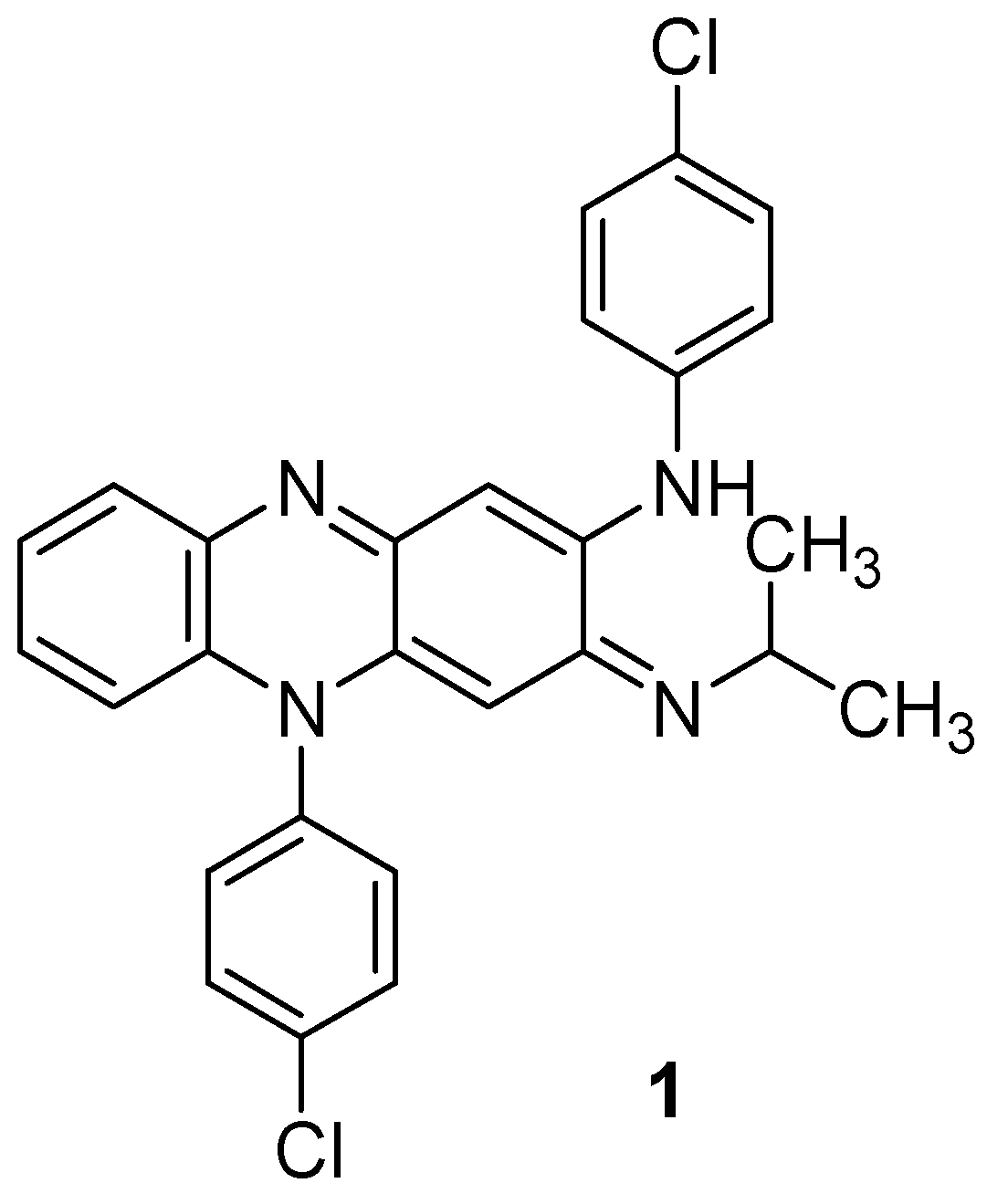
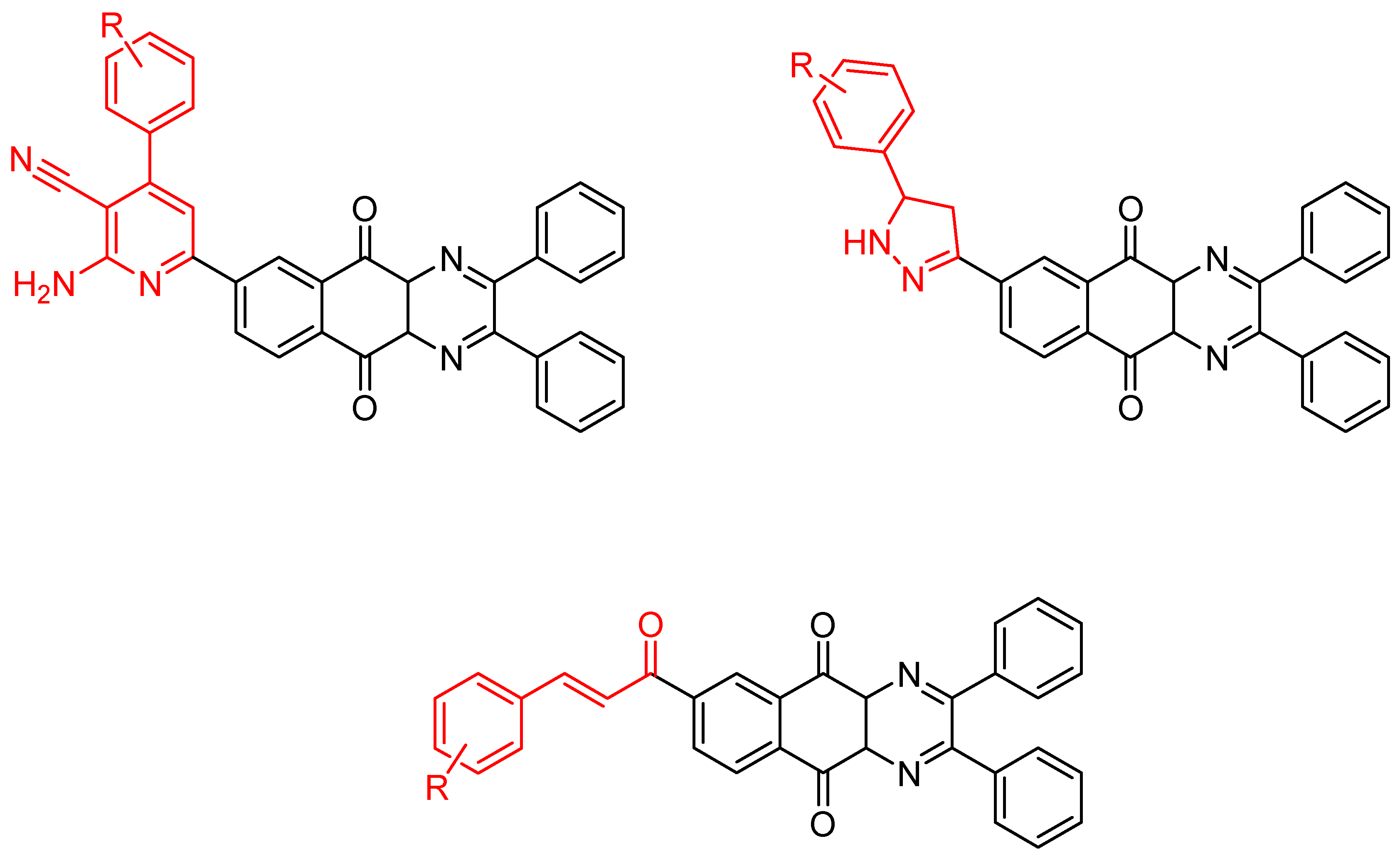
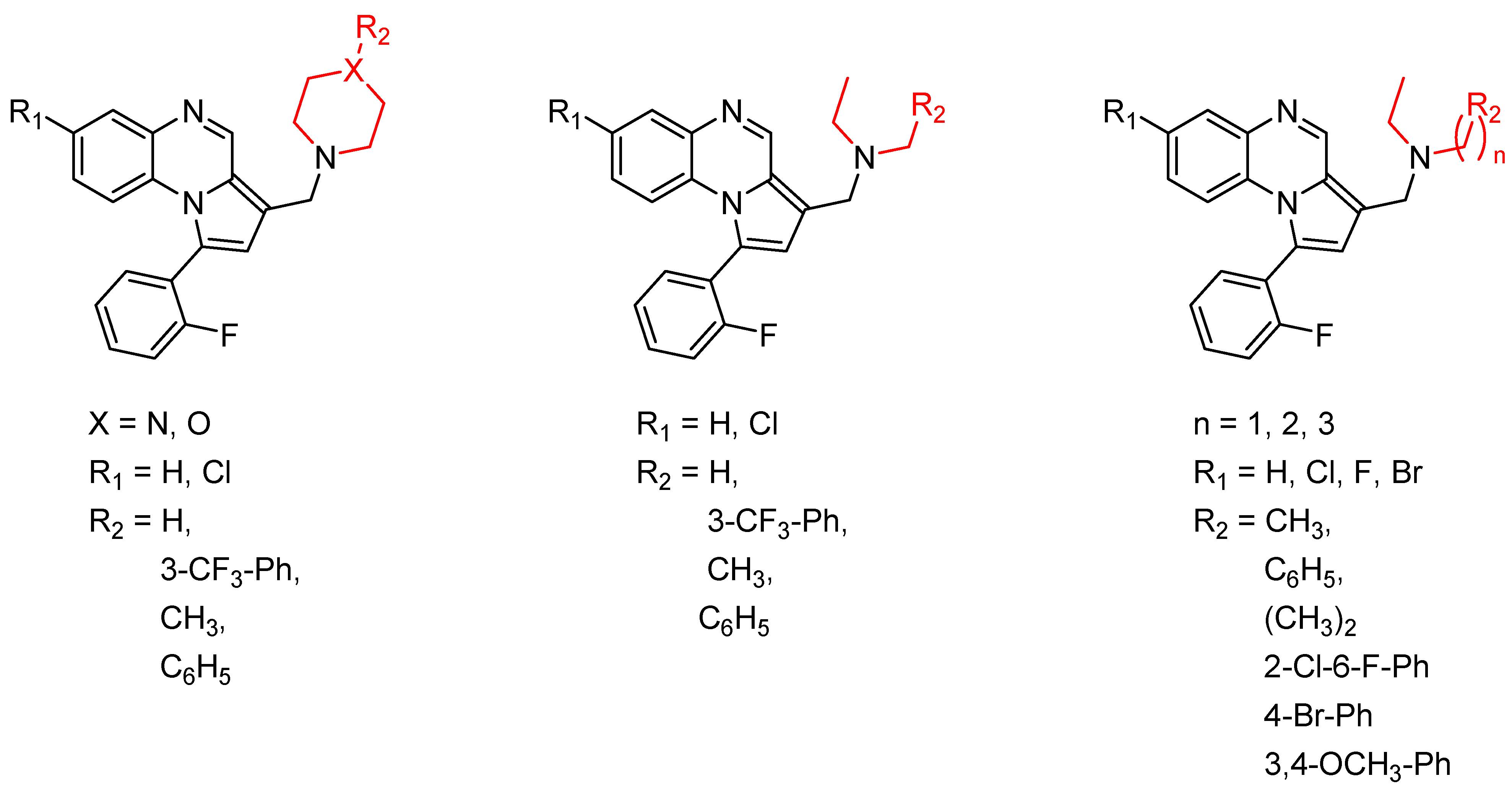

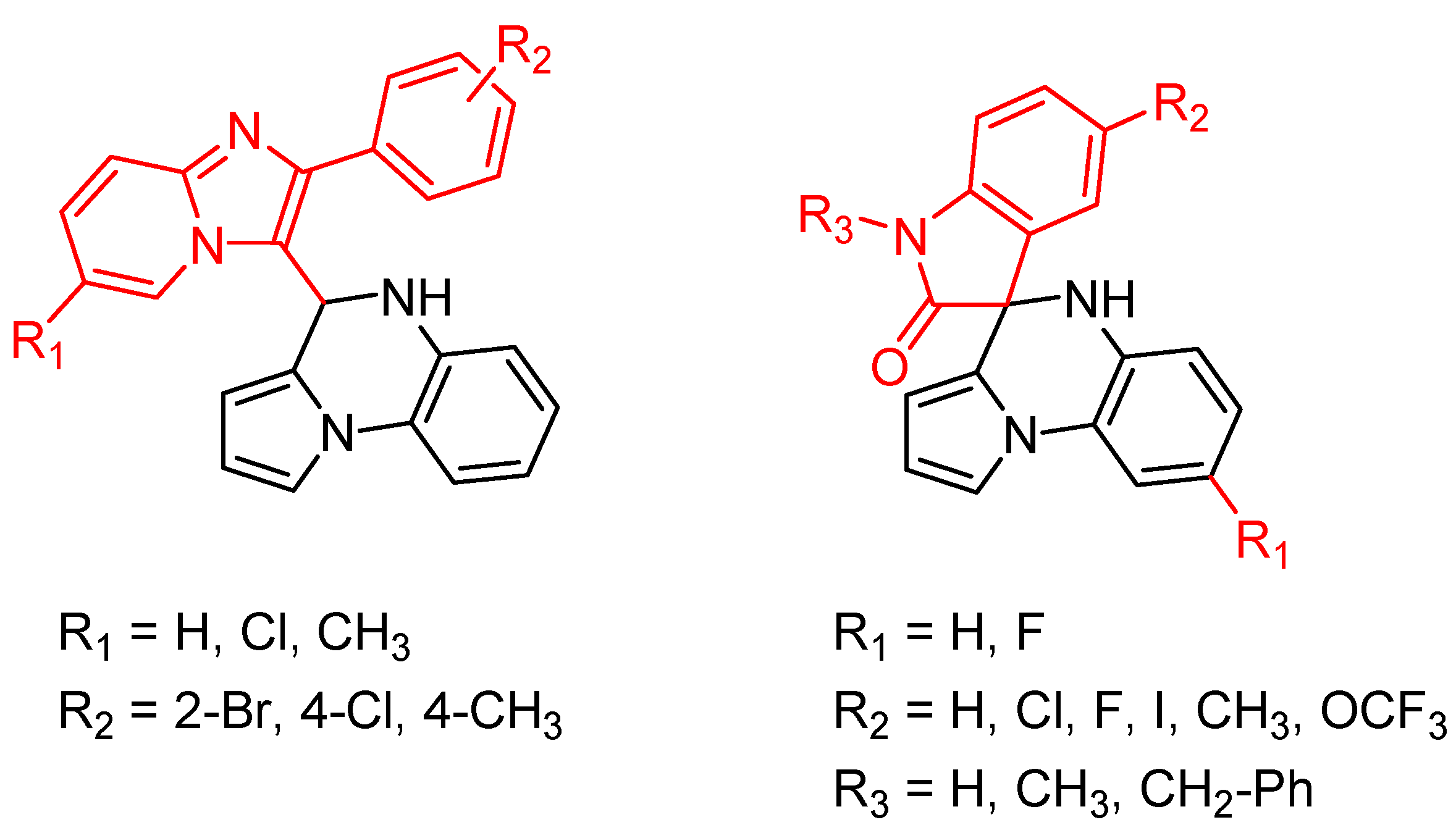
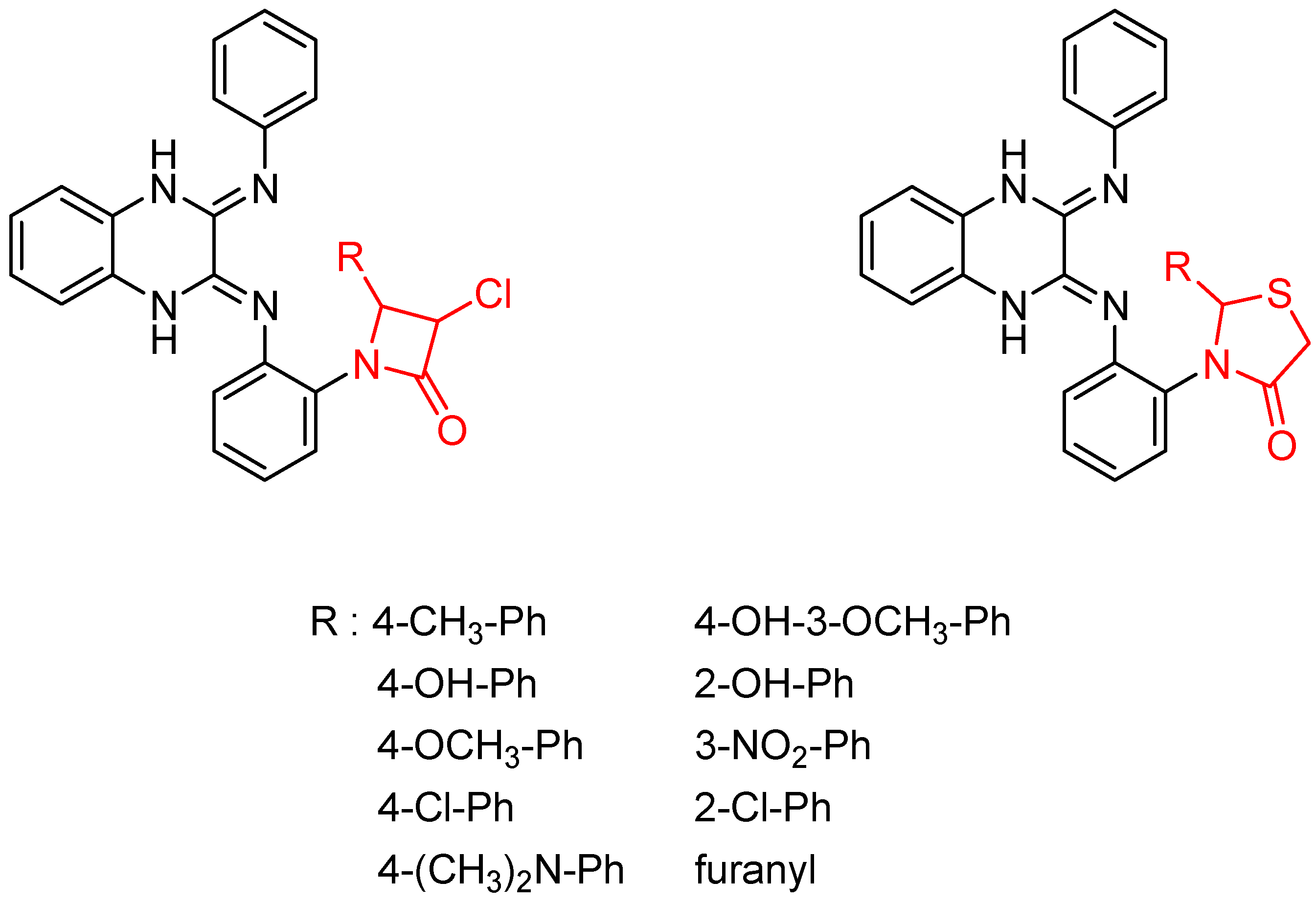
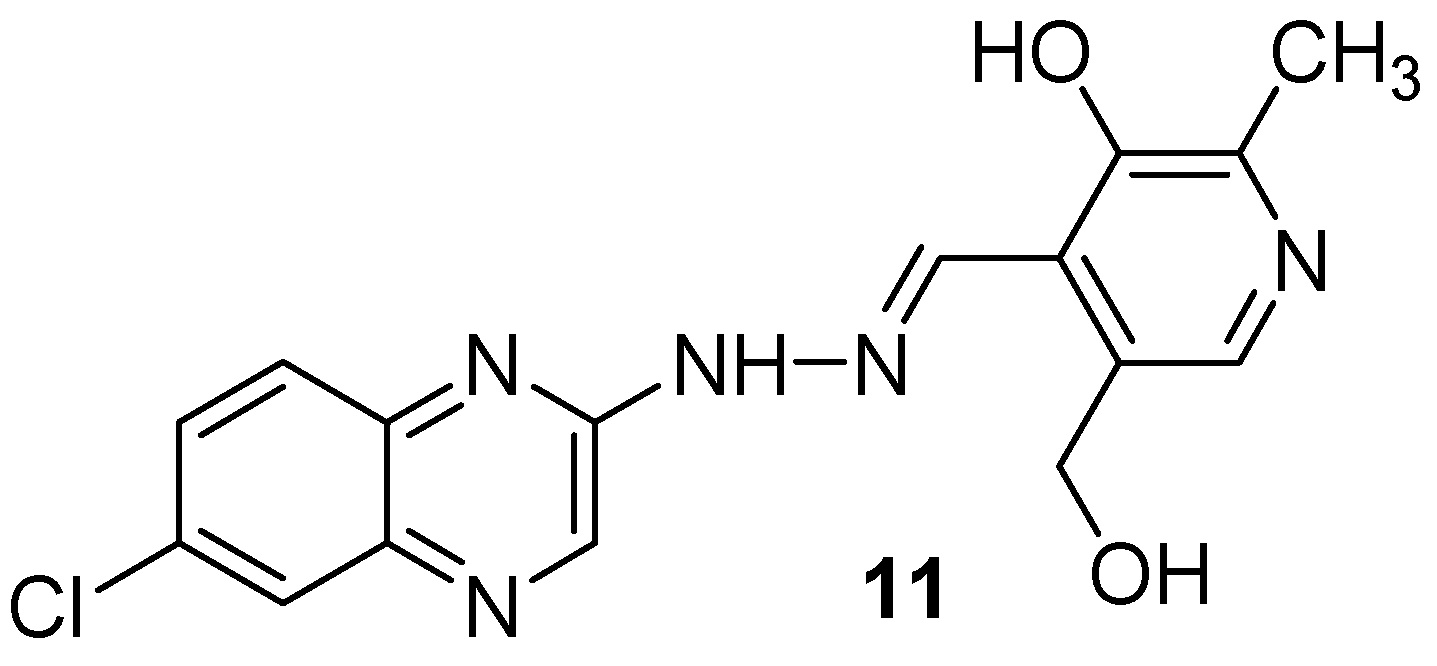


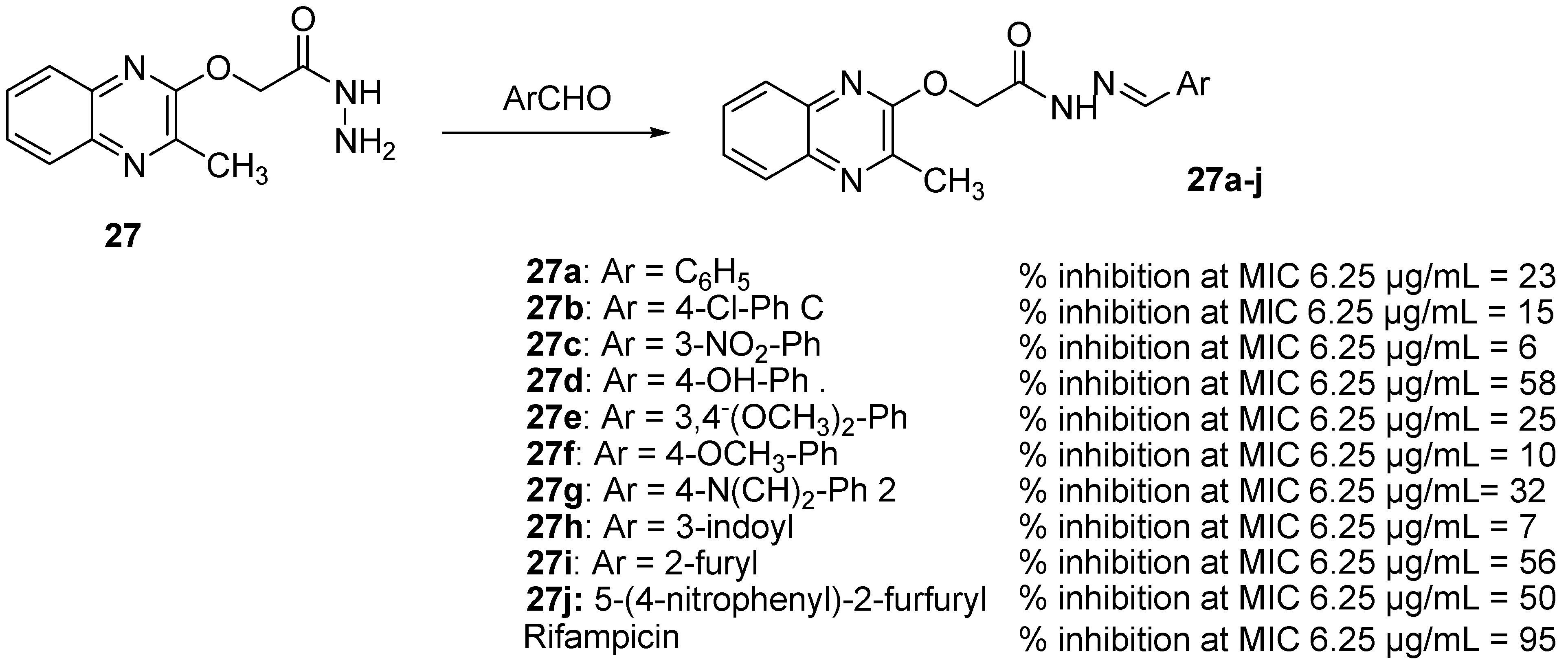
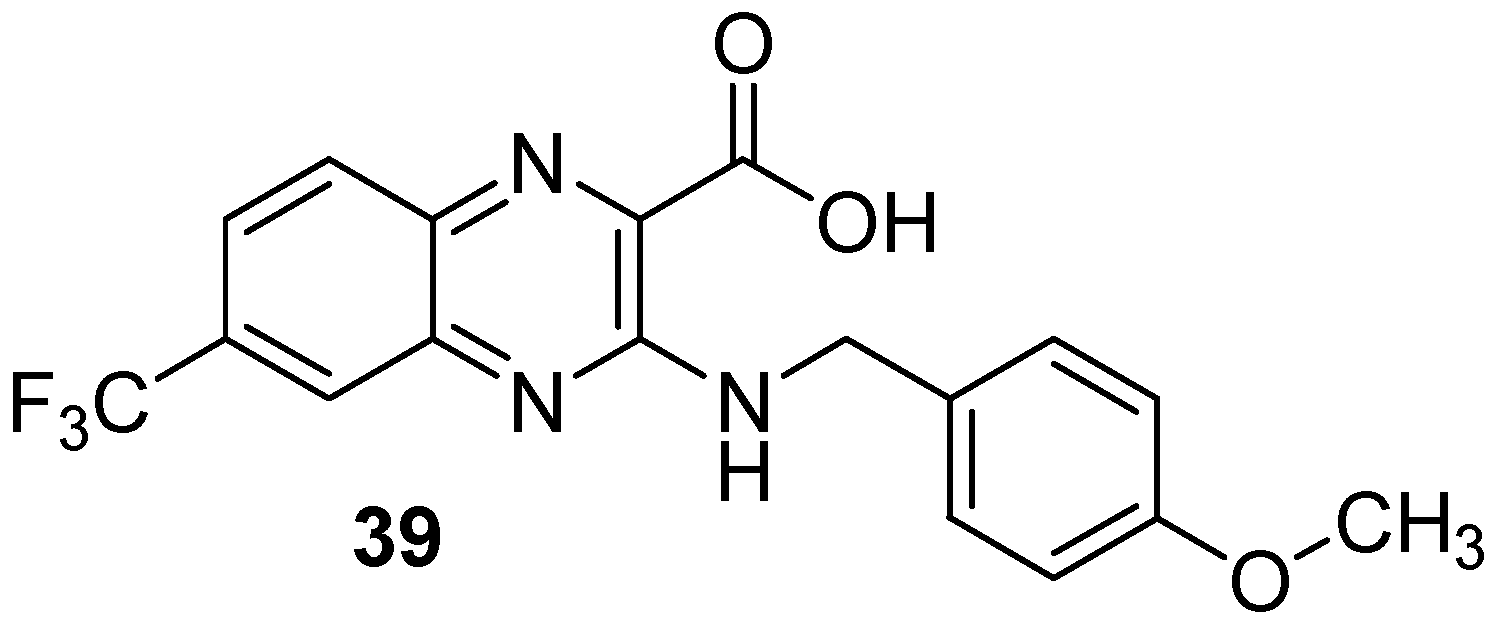
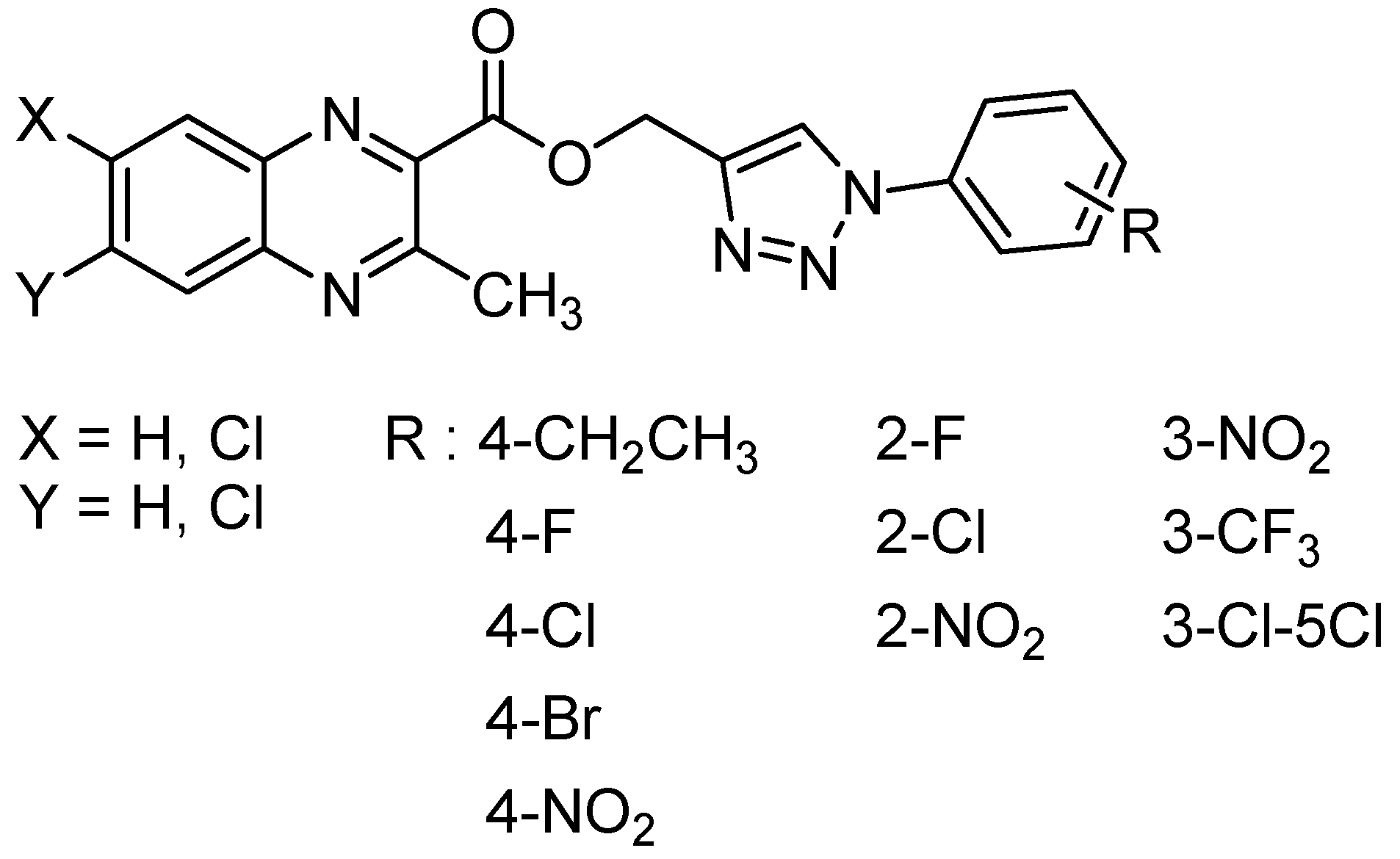
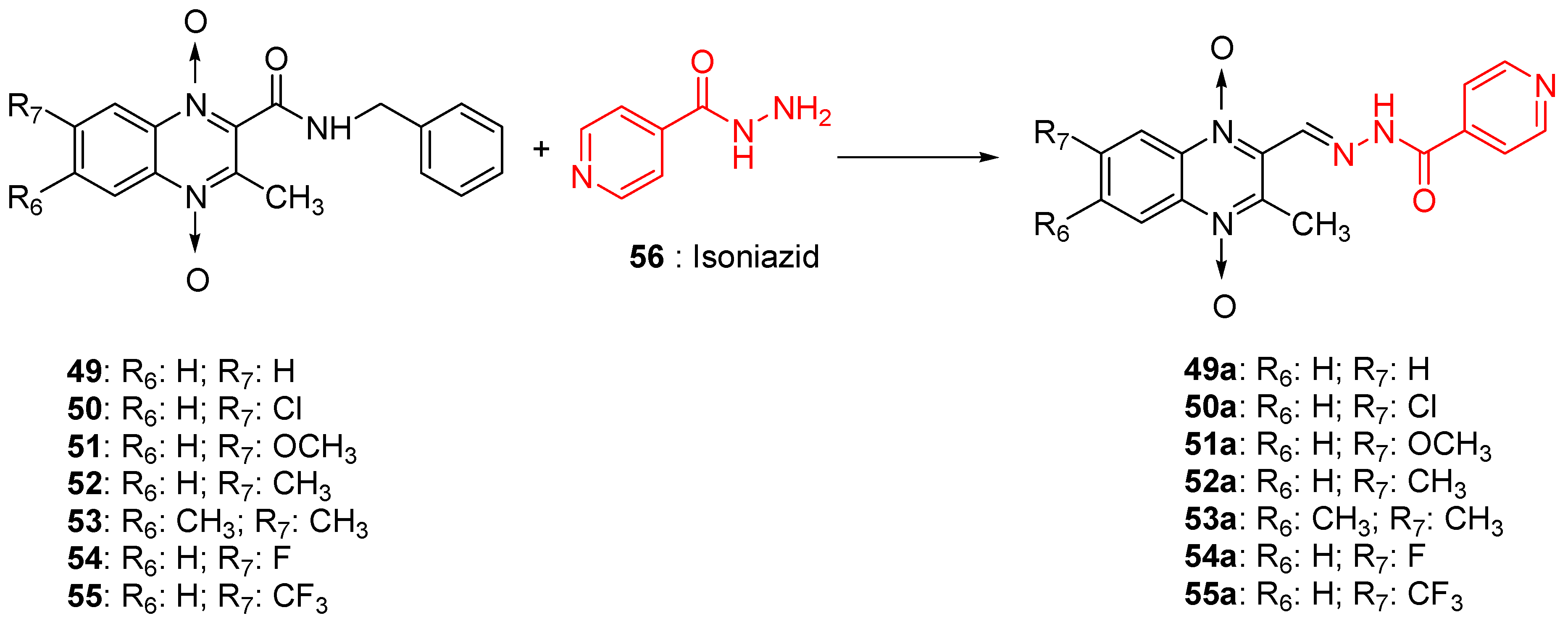
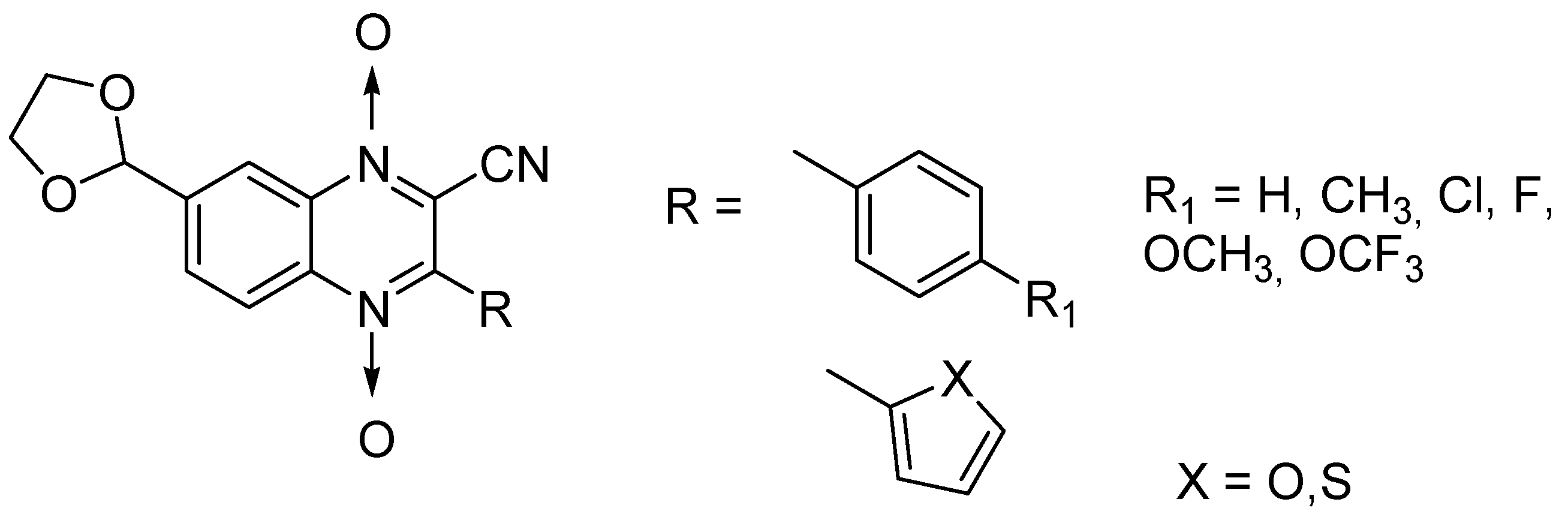
| Site | Keyword 1 | Boolean Operator | Keyword 2 | Date | Filter |
|---|---|---|---|---|---|
| MEDLINE/PubMed (National Library of Medicine—www.ncbi.nlm.nih.gov/pubmed (accessed on 13 April 2021) | Quinoxaline | AND | Tuberculosis | 01 January 2011–01 April 2021 | Document type: journal articles |
| Web of Science (Thomson Reuters Scientific—www.webofknowledge.com (accessed on 13 April 2021) | Quinoxaline (topic) | AND | Tuberculosis (Topic) | 2011–2021 | Document type: only articles |
| Science Direct Elsevier (www.sciencedirect.com (accessed on 13 April 2021) | Quinoxaline | AND | Tuberculosis | 2011–2021 | Document type: only research articles |
| Parameter | Inclusion | Exclusion | |
|---|---|---|---|
| 1 | Language | French, English | Any other language |
| 2 | Type of study | In vitro and/or in vivo studies, biological activity | Articles that focus only on synthesis or other purely chemical parameters |
| 3 | Type of publication | Original manuscripts | Book chapters, posters, reviews |
| 4 | Search terms | Merely citing keywords in the text |
| Compound | Structure | MIC (µg/mL) |
|---|---|---|
| 2 | 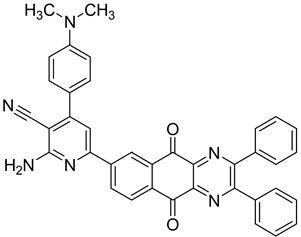 | 50 |
| 3 |  | 12.5 |
| 4 | 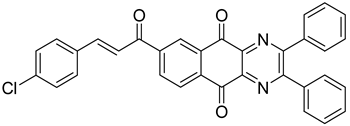 | 25 |
| 5 |  | 12.5 |
| 6 |  | 25 |
| Rifampicin | – | 0.25 |
| Isoniazid | – | 0.20 |
| Compound | Structure | MIC (µg/mL) |
|---|---|---|
| 7 | 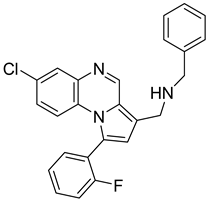 | 5 |
| 8 | 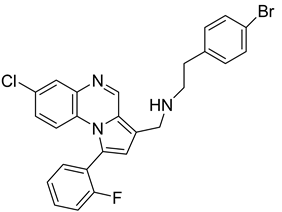 | 5 |
| 9 | 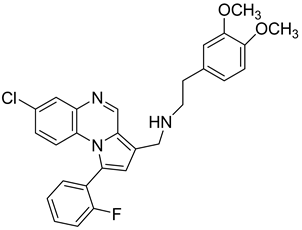 | 5 |
| 10 | 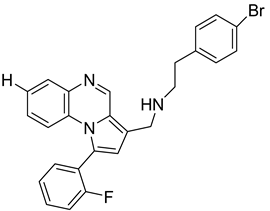 | 5 |
| Compound | Structure | MIC (µg/mL) |
|---|---|---|
| 14 |  | 3.12 |
| 15 |  | 3.12 |
| 16 |  | 50 |
| 17 |  | 25 |
| 18 |  | 25 |
| Streptomycin | 6.25 | |
| Ciprofloxacin | 3.12 | |
| Pyrazinamide | 3.12 |
| Compound | Structure | MIC (µg/mL) |
|---|---|---|
| 19 |  | 12.5 |
| 20 |  | 3.13 |
| 21 |  | 12.5 |
| 22 | 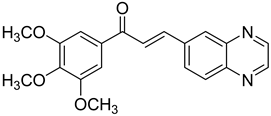 | 6.25 |
| 23 |  | 12.5 |
| 24 |  | 5 |
| Rifampicin | <0.2 | |
| Moxifloxacin | <0.2 | |
| Isoniazid | 0.39 |
| Compound | Structure | MIC (µg/mL) |
|---|---|---|
| 28 | 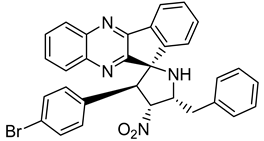 | 3.125 |
| 29 |  | 6.25 |
| 30 | 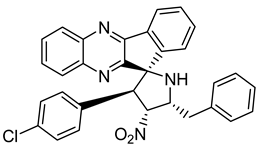 | 12.5 |
| 31 | 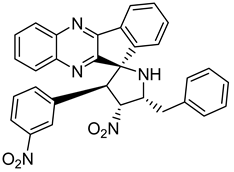 | 1.56 |
| Ethambutol | 1.56 | |
| Rifampicin | 0.1 | |
| Isoniazid | 0.05 |
| Compound | Structure | MIC90 (µM) |
|---|---|---|
| 32 |  | 4.26 |
| 33 |  | 4.55 |
| 34 |  | 1.13 |
| 35 |  | 6.47 |
| 36 | 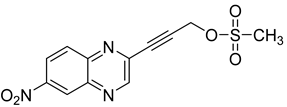 | 1.59 |
| 37 |  | 1.80 |
| 38 | 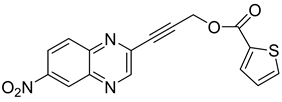 | 2.74 |
| Rifampicin | 0.01 |
| Compound | Structure | MIC (µM) |
|---|---|---|
| 40 | 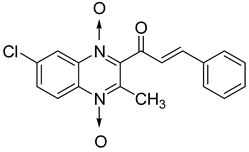 | 3.1 |
| 41 |  | 3.1 |
| 42 | 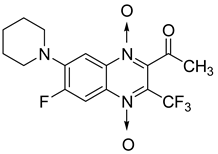 | 1.6 |
| 43 |  | 1.6 |
| 44 | 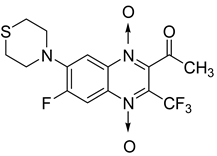 | 3.1 |
| Ethambutol | 6.2 | |
| Rifampicin | 0.3 | |
| Isoniazid | 0.04 |
| Compound | Structure | MIC (µg/mL) |
|---|---|---|
| 45 |  | 1.56 |
| 46 | 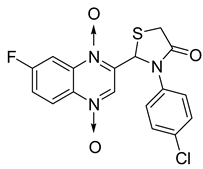 | 1.56 |
| 47 |  | 1.56 |
| 48 |  | 1.56 |
| Rifampicin | 0.125 |
| Compound | Structure | MIC (µg/mL) |
|---|---|---|
| 57 |  | 1.56 |
| 58 | 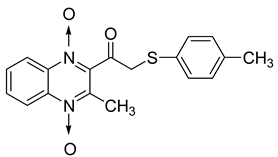 | 0.78 |
| 59 | 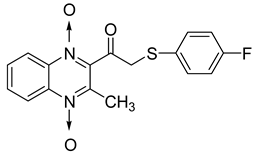 | 0.39 |
| 60 | 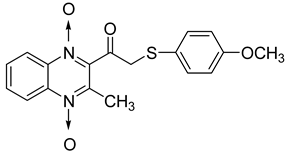 | 0.78 |
| 61 | 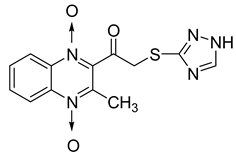 | 0.39 |
| 62 | 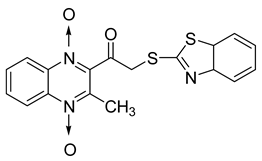 | 1.56 |
| Isoniazid | 0.2 |
| Compound | Structure | Microplate Alamar Blue Assay MIC (µg/mL) |
|---|---|---|
| 63 | 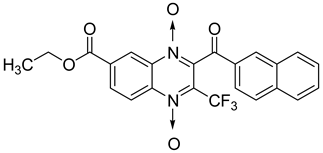 | 0.14 |
| 64 |  | 0.10 |
| 65 | 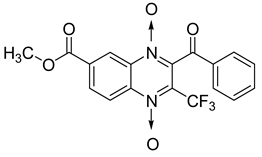 | 0.15 |
| 66 | 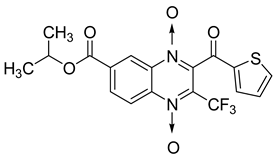 | 0.08 |
| 67 | 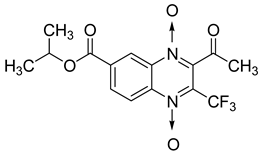 | 0.14 |
| 68 | 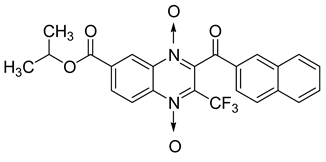 | 0.15 |
| 69 |  | 0.13 |
| 70 | 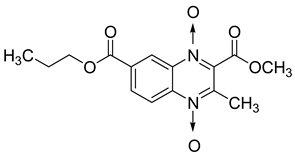 | 0.14 |
| Isoniazid | 0.12 |
Publisher’s Note: MDPI stays neutral with regard to jurisdictional claims in published maps and institutional affiliations. |
© 2021 by the authors. Licensee MDPI, Basel, Switzerland. This article is an open access article distributed under the terms and conditions of the Creative Commons Attribution (CC BY) license (https://creativecommons.org/licenses/by/4.0/).
Share and Cite
Montana, M.; Montero, V.; Khoumeri, O.; Vanelle, P. Quinoxaline Moiety: A Potential Scaffold against Mycobacterium tuberculosis. Molecules 2021, 26, 4742. https://doi.org/10.3390/molecules26164742
Montana M, Montero V, Khoumeri O, Vanelle P. Quinoxaline Moiety: A Potential Scaffold against Mycobacterium tuberculosis. Molecules. 2021; 26(16):4742. https://doi.org/10.3390/molecules26164742
Chicago/Turabian StyleMontana, Marc, Vincent Montero, Omar Khoumeri, and Patrice Vanelle. 2021. "Quinoxaline Moiety: A Potential Scaffold against Mycobacterium tuberculosis" Molecules 26, no. 16: 4742. https://doi.org/10.3390/molecules26164742
APA StyleMontana, M., Montero, V., Khoumeri, O., & Vanelle, P. (2021). Quinoxaline Moiety: A Potential Scaffold against Mycobacterium tuberculosis. Molecules, 26(16), 4742. https://doi.org/10.3390/molecules26164742







